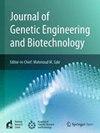研究致癌基因FAM83A作为肺腺癌预后生物标志物的作用:来自吸烟者和非吸烟者队列的见解
IF 2.8
Q3 Biochemistry, Genetics and Molecular Biology
Journal of Genetic Engineering and Biotechnology
Pub Date : 2025-10-08
DOI:10.1016/j.jgeb.2025.100581
引用次数: 0
摘要
肺腺癌(LUAD)在吸烟者和非吸烟者中表现出不同的临床特征,包括遗传学、治疗反应和预后的差异。为了探索这些差异,我们使用可公开访问的LUAD数据集进行了荟萃分析,确定吸烟者和非吸烟者的元差异表达基因(DEGs)。共发现29个meta- deg,其中7个(CLDN2、CLDN18、CYP4B1、CYP4X1、FAM83A、HLF和PLA2G1B)在TCGA-LUAD队列中具有预后意义。其中FAM83A在LUAD样品中的扩增尤其值得注意,且与免疫细胞浸润呈负相关。功能富集分析揭示了关键途径,如细胞色素P450代谢和细胞-细胞粘附,这可能是LUAD进展的关键。我们的研究结果强调FAM83A是一种潜在的预后生物标志物,对治疗策略具有重要意义,特别是在免疫调节方面。这项研究为吸烟者和非吸烟者LUAD的分子差异提供了更全面的见解,并为针对这些亚群的靶向治疗奠定了基础。本文章由计算机程序翻译,如有差异,请以英文原文为准。
Investigating the role of oncogenic FAM83A as a prognostic biomarker in lung adenocarcinoma: Insights from smoker and non-smoker cohorts
Lung adenocarcinoma (LUAD) in smokers and non-smokers presents distinct clinical characteristics, including differences in genetics, treatment response, and prognosis. To explore these differences, we conducted a meta-analysis using publicly accessible LUAD datasets, identifying meta-differentially expressed genes (DEGs) in smokers and non-smokers. A total of meta-DEGs were discovered, with seven (CLDN2, CLDN18, CYP4B1, CYP4X1, FAM83A, HLF, and PLA2G1B) demonstrating prognostic significance in the TCGA-LUAD cohort. Among these, FAM83A was particularly noteworthy for its amplification in LUAD samples and its negative correlation with immune cell infiltration. Functional enrichment analysis revealed key pathways, such as cytochrome P450 metabolism and cell–cell adhesion, which may be critical in LUAD progression. Our findings highlight FAM83A as a potential prognostic biomarker with significant implications for treatment strategies, especially concerning immune modulation. This study offers a more comprehensive insight into the molecular differences in LUAD in smokers and non-smokers and lays the groundwork for targeted therapies tailored to these subgroups.
求助全文
通过发布文献求助,成功后即可免费获取论文全文。
去求助
来源期刊

Journal of Genetic Engineering and Biotechnology
Biochemistry, Genetics and Molecular Biology-Biotechnology
CiteScore
5.70
自引率
5.70%
发文量
159
审稿时长
16 weeks
期刊介绍:
Journal of genetic engineering and biotechnology is devoted to rapid publication of full-length research papers that leads to significant contribution in advancing knowledge in genetic engineering and biotechnology and provide novel perspectives in this research area. JGEB includes all major themes related to genetic engineering and recombinant DNA. The area of interest of JGEB includes but not restricted to: •Plant genetics •Animal genetics •Bacterial enzymes •Agricultural Biotechnology, •Biochemistry, •Biophysics, •Bioinformatics, •Environmental Biotechnology, •Industrial Biotechnology, •Microbial biotechnology, •Medical Biotechnology, •Bioenergy, Biosafety, •Biosecurity, •Bioethics, •GMOS, •Genomic, •Proteomic JGEB accepts
 求助内容:
求助内容: 应助结果提醒方式:
应助结果提醒方式:


